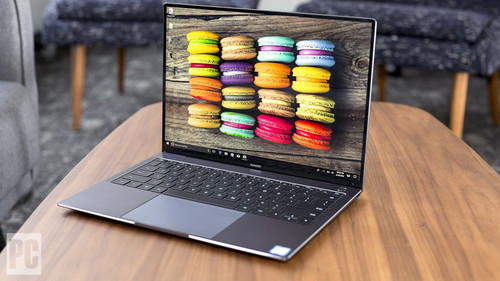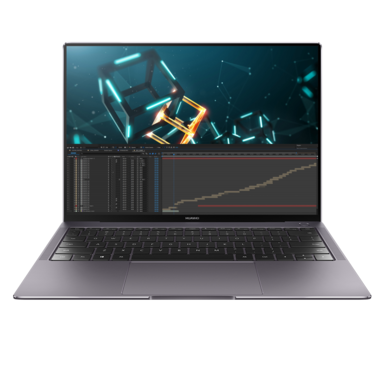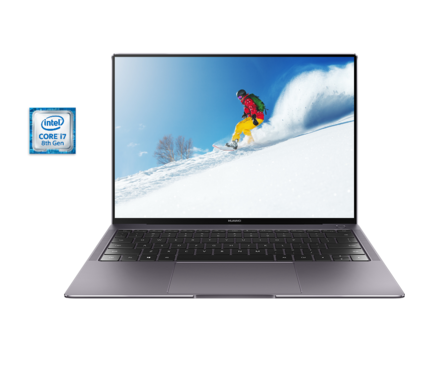For a time, Dell’s XPS series dominated the Windows Ultrabook market. The premium notebook combines high-performance internals with an excellent 4k screen and wrapped those up with a slick carbon fiber body. This resulted in one of the most recommended laptops of all time bagging the best Ultrabook category year after year.
This year, however, a relative newcomer in the laptop market Huawei is pitting a veritable r ival to the XPS with their MateBook X Pro. It offers much of the same selling points such as premium materials and powerful internals but it’s far from being a clone. It, however, rather closely resembles another top laptop in Apple’s MacBook Pro with its aluminum unibody build and space gray colorway. The naming is also so obviously a nod to its likeness with the Apple computer. But that’s not such a bad thing because the MacBook Pro is an excellent looking Ultrabook. The thing is, even if Huawei decides to copy everything from the MacBook Pro, the difference in the operating system is so stark that it’s never really a MacBook Pro rival.
Essentially, the MateBook X Pro is MacBook Pro with Windows installed on it; and that’s one of the best things about it. Now, let’s get into the details.
Build
Its build is perhaps the best thing about the MateBook X Pro. Its design aesthetic closely resembles that of the MacBook Pro. The Taiwanese computer makers, however, look like they took note of consumer’s complaints about Apple’s computer and made it better. It starts with the enlarged trackpad with a glass surface; paired with Window’s Precision drivers and we’ve got an absolute winner of a trackpad with the MateBook X Pro. They also decided not to copy Apple’s controversial touch bar. What they end up with is a no-nonsense Ultrabook that offers only top quality notebook essentials.
The aluminum unibody is slimmer at its thinnest point than its closest real rival in Dell’s XPS 13. It is, however, heavier because of the material. But, at just 0.3lbs difference, we couldn’t really give this a win for the XPS. It’s so small that it’s a non-issue.
Screen
When it comes to screen, Dell was the innovator and Huawei is, for the most part, a follower in the bezel-less trend. But, arguably, the MateBook X Pro overtook the XPS 13 when it comes to screen profile. The Dell laptop is a 13-inch laptop in an 11-incher’s body. Huawei’s on the other hand, is a 14-incher in a 13-incher’s body. The small difference goes a long way in the viewing experience as the MateBook’s screen offers a lot more screen real estate to display information.
Its quality of the MateBook X Pro’s 3K display, despite being beaten by the XPS’s 4K display, looks just as good to the naked eye. Huawei’s laptop also outclasses Dell’s in terms of brightness, contrast, and overall color accuracy.
Furthermore, the 3:2 aspect ratio also makes Huawei’s Ultrabook offering a much better productivity device as it displays even more vertical space to display more website, spreadsheet, or word processing information. However, when it comes to audiovisual content consumption, the unconventional screen ratio would most definitely result in larger black bars.
Internals
The MateBook X Pro offers the latest in Intel's Core technology. It's actually great timing on the side of Huawei as Intel just made one of the biggest leaps in computing technology that they've made in a while. While previous generations just offered an incremental increase in power efficiency and overall performance, this 8 th generation of Intel chips actually increased in the number of cores. Instead of dual-c ore i-series chipsets, the MateBook X Pro offers quad-core CPUs. This means an even greater increase in efficiency and performance increase from yesteryear’s updates.
Where the MateBook X Pro truly shines, however, is in its 3D rendering capabilities. It has a 2GB VRAM MX150 graphics chip that gives it some oomph in the graphics department versus its competitors in the same segment.
When it comes to battery, the real world use is more underwhelming than the listed specs. The 57.4 watt-hours only produce around 8 hours of real-world use. It's a lot less efficient than Dell's offering that gives off more than 10 hours of real-world use while working with just 52 watt-hours.
Ports
When it comes to ports, the MateBook X Pro is pretty decent but not perfect. It thankfully comes with a future-proofed Thunderbolt 3, a USB Type C, USB Type A, and a 3.5mm headphone jack. What's missing is an SD Card slot that would be most beneficial for photo and video editors looking to maximize the use of that MX150 graphics chip.
When it comes to webcams, the MateBook X Pro offers a solution that’s different from the rest of the bezel-less laptops. While its placement still results in weird angles, the unique way that they hide it in the keyboard is a welcome novelty. It also takes into consideration privacy concerns that some laptop owners might have.
Pricing & Verdict
There are two versions of the MateBook X Pro available to consumers. A $1,199 comes in with an i5 8250U processor with 8GB RAM and 256GB SSD and a $1,499 model come with an i7 8550, 16GB RAM, 512 GB SSD, and the discrete MX150. Comparing the similarly equipped top-tier models of the MateBook X Pro and the XPS 13, the Huawei’s laptop is a full $500 cheaper.
Given the total package, there is a new top Ultrabook in the MateBook X Pro, it seems. While it does cut some corners and it still has some unsavory design elements such as camera placement, they’re minimal enough to not make much difference compared to the previous favorite in the XPS 13. The MateBook X Pro, however, focused on the more important features. In areas such as the screen, price, and graphical performance, Huawei's computer outclasses Dell's offering.
This year, however, a relative newcomer in the laptop market Huawei is pitting a veritable r ival to the XPS with their MateBook X Pro. It offers much of the same selling points such as premium materials and powerful internals but it’s far from being a clone. It, however, rather closely resembles another top laptop in Apple’s MacBook Pro with its aluminum unibody build and space gray colorway. The naming is also so obviously a nod to its likeness with the Apple computer. But that’s not such a bad thing because the MacBook Pro is an excellent looking Ultrabook. The thing is, even if Huawei decides to copy everything from the MacBook Pro, the difference in the operating system is so stark that it’s never really a MacBook Pro rival.
Essentially, the MateBook X Pro is MacBook Pro with Windows installed on it; and that’s one of the best things about it. Now, let’s get into the details.
Build
Its build is perhaps the best thing about the MateBook X Pro. Its design aesthetic closely resembles that of the MacBook Pro. The Taiwanese computer makers, however, look like they took note of consumer’s complaints about Apple’s computer and made it better. It starts with the enlarged trackpad with a glass surface; paired with Window’s Precision drivers and we’ve got an absolute winner of a trackpad with the MateBook X Pro. They also decided not to copy Apple’s controversial touch bar. What they end up with is a no-nonsense Ultrabook that offers only top quality notebook essentials.
The aluminum unibody is slimmer at its thinnest point than its closest real rival in Dell’s XPS 13. It is, however, heavier because of the material. But, at just 0.3lbs difference, we couldn’t really give this a win for the XPS. It’s so small that it’s a non-issue.
Screen
When it comes to screen, Dell was the innovator and Huawei is, for the most part, a follower in the bezel-less trend. But, arguably, the MateBook X Pro overtook the XPS 13 when it comes to screen profile. The Dell laptop is a 13-inch laptop in an 11-incher’s body. Huawei’s on the other hand, is a 14-incher in a 13-incher’s body. The small difference goes a long way in the viewing experience as the MateBook’s screen offers a lot more screen real estate to display information.
Its quality of the MateBook X Pro’s 3K display, despite being beaten by the XPS’s 4K display, looks just as good to the naked eye. Huawei’s laptop also outclasses Dell’s in terms of brightness, contrast, and overall color accuracy.
Furthermore, the 3:2 aspect ratio also makes Huawei’s Ultrabook offering a much better productivity device as it displays even more vertical space to display more website, spreadsheet, or word processing information. However, when it comes to audiovisual content consumption, the unconventional screen ratio would most definitely result in larger black bars.
Internals
The MateBook X Pro offers the latest in Intel's Core technology. It's actually great timing on the side of Huawei as Intel just made one of the biggest leaps in computing technology that they've made in a while. While previous generations just offered an incremental increase in power efficiency and overall performance, this 8 th generation of Intel chips actually increased in the number of cores. Instead of dual-c ore i-series chipsets, the MateBook X Pro offers quad-core CPUs. This means an even greater increase in efficiency and performance increase from yesteryear’s updates.
Where the MateBook X Pro truly shines, however, is in its 3D rendering capabilities. It has a 2GB VRAM MX150 graphics chip that gives it some oomph in the graphics department versus its competitors in the same segment.
When it comes to battery, the real world use is more underwhelming than the listed specs. The 57.4 watt-hours only produce around 8 hours of real-world use. It's a lot less efficient than Dell's offering that gives off more than 10 hours of real-world use while working with just 52 watt-hours.
Ports
When it comes to ports, the MateBook X Pro is pretty decent but not perfect. It thankfully comes with a future-proofed Thunderbolt 3, a USB Type C, USB Type A, and a 3.5mm headphone jack. What's missing is an SD Card slot that would be most beneficial for photo and video editors looking to maximize the use of that MX150 graphics chip.
When it comes to webcams, the MateBook X Pro offers a solution that’s different from the rest of the bezel-less laptops. While its placement still results in weird angles, the unique way that they hide it in the keyboard is a welcome novelty. It also takes into consideration privacy concerns that some laptop owners might have.
Pricing & Verdict
There are two versions of the MateBook X Pro available to consumers. A $1,199 comes in with an i5 8250U processor with 8GB RAM and 256GB SSD and a $1,499 model come with an i7 8550, 16GB RAM, 512 GB SSD, and the discrete MX150. Comparing the similarly equipped top-tier models of the MateBook X Pro and the XPS 13, the Huawei’s laptop is a full $500 cheaper.
Given the total package, there is a new top Ultrabook in the MateBook X Pro, it seems. While it does cut some corners and it still has some unsavory design elements such as camera placement, they’re minimal enough to not make much difference compared to the previous favorite in the XPS 13. The MateBook X Pro, however, focused on the more important features. In areas such as the screen, price, and graphical performance, Huawei's computer outclasses Dell's offering.



